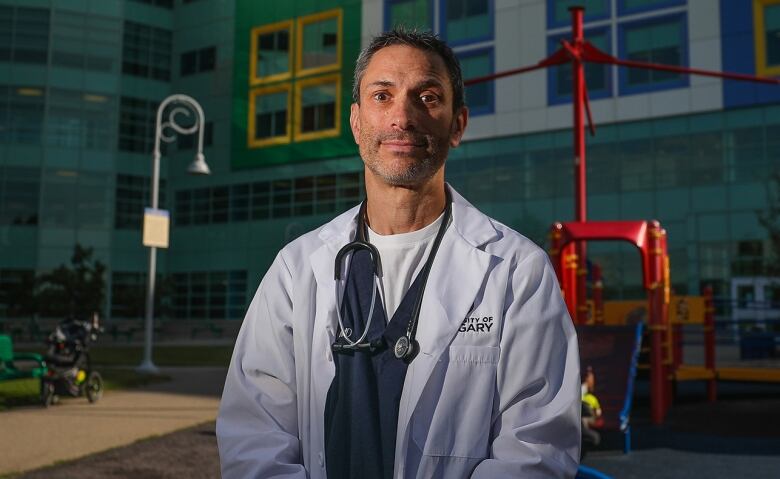What is shiga toxin-producing E. coli and why are Calgary children getting so sick?
A ballooning E.coli outbreak connected to Calgary-area daycares is sending dozens of children to hospital, some with serious complications, and sparking concern among parents and doctors alike.
According to Alberta Health Services (AHS), 128 cases of an E. coli strain that can be particularly dangerous for young kids have been identified so far and 25 children are in hospital.
In addition, three patients have already been released and three more are being treated in other provinces.
What is most worrisome, doctors say, is that nine children have been diagnosed with a severe complication that can force kids into dialysis treatment.
“This is not the typical type of E. coli that causes maybe a day or two of watery diarrhea, or ‘traveler’s diarrhea,’ that some people talk about,” said Dr. Stephen Freedman, an ER physician at Alberta Children’s Hospital and professor in the Cumming School of Medicine at the University of Calgary.
This particular strain is a type of E. coli 0157. It is known as Shiga toxin-producing E. coli (STEC) because it secretes a toxin that can lead to serious organ damage, often targeting the kidneys.
“This is one of the most distressing illnesses that we see,” Freedman said in an interview on The Calgary Eyeopener.

Complications include kidney failure
This strain is often carried by cattle and can contaminate food, including meat (through the slaughtering process) and fresh produce (through water tainted by infected animal feces).
Eleven child-care centers have been shut down by health officials as they search for the source of this outbreak. Public health investigators suspect the culprit is likely a common food served from a central kitchen.
What is so problematic about this outbreak, according to doctors, is that it has taken root among children under the age of five — one of the most vulnerable groups.
“What’s scary about this one is that it seems to have a large number of kids involved,” said Dr. Cora Constantinescu, an infectious diseases specialist at Alberta Children’s Hospital.
Early in the infection, symptoms can include diarrhea (sometimes bloody), vomiting, and fever.
However, the toxin can eventually lead to a condition known as hemolytic uremic syndrome (HUS), where the toxin enters the bloodstream and attacks the kidneys, potentially leading to kidney failure.
According to Constantinescu, while most children who are infected will recover, approximately 10 to 20 percent will go on to develop HUS.
Half of those children will end up on dialysis for kidney failure.
“Because this is a serious condition, this is why we’re being so hyper-vigilant about it,” she said.
On Thursday, AHS confirmed nine children had been diagnosed with HUS. But the health authority didn’t say how many patients are on dialysis.

‘Insidious’ illness
Treatment for this type of E. coli includes intravenous fluids to manage dehydration.
And because HUS can be quietly damaging the organs as initial symptoms appear to resolve, infected children, including those who don’t require hospitalization, need close monitoring, including blood tests every 24 hours.
“It is quite insidious. So it kind of starts to manifest when the children seem to be getting better. But it’s then that the complications start to emerge,” Freedman said.
“You’re taking a previously healthy toddler to dialysis in about six days.”
Key symptoms
Doctors are urging parents to watch their children closely.
“If your child has symptoms, they should be seen. Don’t manage that at home because it could start pretty mild but then end up pretty bad,” said Constantinescu.
AHS has set up a webpage for Albertans looking for information on this E. coli outbreak.
“We have a lot of worried parents and families,” said Dr. Tania Principi, a pediatric ER physician and clinical associate professor at the University of Calgary.
According to Principi, children connected to the outbreak who show any of the following symptoms should be taken to the emergency room:
- diarrhea (may or may not be bloody)
- inability to drink fluids
- Infrequent urination (less than once every 12 hours)
- tea-colored urine
- unexplained bleeding, bruising, or a purple rash
- severe abdominal pain, severe headaches

“We aim to catch people early on in the illness and ensure that they have adequate hydration to try and prevent that cascade or that deterioration to worse outcomes,” said Principi.
Deaths are extremely rare, she noted. No children have died as a result of this outbreak, according to AHS.
University of Alberta infectious disease specialist, Dr. Lynora Saxinger, said there could also be longer-term health problems.
“Most kids, even those with more severe organ damage, do recover to have functional kidneys again,” she said.
“But even some of those can later on show that they actually have lost some kidney function and might need special monitoring in the future as well.”
Community transmission
There are also concerns about secondary infections if children spread the illness to family members or other close contacts.
The bacteria can pass from one person to another through fecal-oral transmission. That can happen if someone doesn’t wash their hands properly after going to the bathroom or changing a diaper, for example.
“Within-household transmission is a major concern,” said Freedman, noting seniors are another very high-risk group.
“For those grandparents who are involved in care, I would try to minimize or eliminate exposure if at all possible.”
Meanwhile, he estimates the onslaught of cases will hit its peak this weekend.
According to Freedman, children usually start having symptoms within 10 days of exposure, often earlier. If there are complications, the need for dialysis usually occurs about seven days after symptoms begin.





